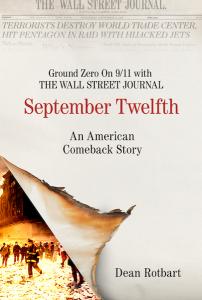9/11 Turns 20: Medill School of Journalism Alum Pens History of The Wall Street Journal on September 11th
Poynter Institute says Dean Rotbart’s “September Twelfth” is the most detailed and dramatic look yet at The Wall Street Journal’s Pulitzer-winning work on 9/11.
Signed copies of the book, in hardcover or softcover, are available at no additional cost from Gutenberg's Store. Softcover copies are also for sale on Amazon.
Rotbart, a 1979 graduate of the Medill School of Journalism at Northwestern University, wrote the book to coincide with the 20th anniversary of the terrorist attacks.
“September Twelfth: An American Comeback Story” relies on dozens of interviews and more than one thousand real-time emails and memos to reconstruct the 15 hours between the time that the first plane struck the North Tower and when the final edition of the next day’s Journal rolled off the presses.
“No one would have blamed staff of The Wall Street Journal if the paper hadn’t been able to publish on September 12th because the Journal faced so many seemingly insurmountable obstacles,” says Rotbart, who himself was a reporter and columnist with the paper in the 1980s.
Having lost their headquarters’ newsroom, Journal editors and reporters were left scattered throughout the five boroughs of Manhattan and in New Jersey and Connecticut. Phone service was spotty at best. Transportation in and out of Manhattan was halted for much of the day, leaving the emergency backup newsroom in South Brunswick, New Jersey, inaccessible for most of The Wall Street Journal’s New York staff members.
Adding to the chaos was the absence of the paper’s managing editor, Paul E. Steiger, who was incommunicado until early afternoon. Many of Steiger’s colleagues feared he had been killed or seriously injured as a result of the terrorist attacks.
“Journalists, journalism junkies, journalism educators, and history buffs will be enthralled to read how the business and financial reporters and editors at the Journal transformed in a matter of minutes into war correspondents,” Rotbart says. “By today’s standards, the available work-from-home technology in 2001 was primitive, yet dozens of journalists still managed to report and write their next-day stories remotely.”
More than a few Journal reporters witnessed horrors that haunt them to this day, including the death-leaps of those trapped in the upper floors of the World Trade Center, and the severed arms, legs, and heads strewn about the streets below.
For their effort, the paper was awarded the 2002 Pulitzer Prize for Breaking News, the first Pulitzer for that category in the paper’s 112-year history.
Two factors inspired the Journal’s staff to rally on September 11th, according to Rotbart.
First, as journalists, they felt a profound sense of duty to keep their readers informed and, by publishing on September 12th, reassure their subscribers that the world would go on.
Second, the Journal’s team — which included news assistants, graphic designers, software engineers, compositors, printers, and delivery truck drivers — were determined to send a message back to the terror attack masterminds that they would not be bowed by fear or danger.
Rotbart spent nine months researching and writing September Twelfth. The book is an outgrowth of his work on a forthcoming biography of Paul E. Steiger. Steiger not only served 16 years as the managing editor of The Wall Street Journal — the longest anyone has held that influential job — but he went on to found and lead ProPublica, a global leader in investigative, nonprofit journalism.
“Paul and I were speaking weekly so that I could record his oral history. When we got to the topic of 9/11, I was floored, not only by his experience that day but also by the events that impacted all of Dow Jones & Company and the Journal, and the responses of Paul’s colleagues,” Rotbart says. “It was a story that had been told in parts but never in-depth.”
Rotbart credits the Medill School of Journalism at Northwestern University for providing him a strong foundation for his entire journalism career. In particular, he acknowledges his basic writing professor, Emily Soloff, as well as the late Richard Hainey and Benjamin H. Baldwin, who taught him reporting and feature writing, respectively.
After graduating from Northwestern and a summer internship with The Wall Street Journal in Detroit, Rotbart was hired by the Journal as a staff reporter in Cleveland. He subsequently worked for the paper in Denver and Dallas before being transferred to New York to co-write the “Heard on the Street” investment column.
The Journal nominated Rotbart for a Pulitzer Prize in Explanatory Reporting. Also, while at the paper, he won a John Hancock Award for Excellence in Business and Financial Journalism.
Rotbart serves as the chair and editor-in-chief of the “Business News Visionary Awards” and “News Luminary Awards” programs, which recognize outstanding achievements by journalists. Previously, he published the “TJFR Business News Reporter,” an award-winning trade newsletter focused on influential business and financial news organizations.
Since June 2012, Rotbart has produced and hosted Monday Morning Radio, a popular weekly small business podcast.
Working with the non-profit Strider Education Foundation, Rotbart was the co-creator of the nationwide All Kids Bike® drive, a grassroots effort to teach children how to ride a bike before they reach first grade. Rotbart continues to serve as a national ambassador for the movement.
DEAN ROTBART
TJFR Press
+1 303-800-6081
email us here
Visit us on social media:
LinkedIn
Legal Disclaimer:
EIN Presswire provides this news content "as is" without warranty of any kind. We do not accept any responsibility or liability for the accuracy, content, images, videos, licenses, completeness, legality, or reliability of the information contained in this article. If you have any complaints or copyright issues related to this article, kindly contact the author above.


